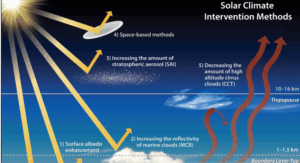
Why in News?
- A recent study published in the journal Earth’s Future has proposed a low-altitude version of Stratospheric Aerosol Injection (SAI) by using modified existing aircraft to reduce global warming.

What is Solar Climate Intervention?
- Solar Climate Intervention involves geoengineering methods which reduce incoming solar radiation, and these methods attempt to counteract the effects of global warming without reducing greenhouse gas emissions.
Key Types of Techniques
- Stratospheric Aerosol Injection (SAI): Spraying sulphur dioxide or other particles into the stratosphere to reflect sunlight and cool Earth.
- Marine Cloud Brightening: Spraying sea salt into marine clouds to increase their reflectivity and reflect more sunlight.
- Space-Based Reflectors: Placing mirrors or shades in space to block part of the incoming solar radiation.
- Surface Albedo Modification: Making Earth’s surfaces more reflective by painting roofs white or planting reflective crops.
How Stratospheric Aerosol Injection (SAI) Works
- Volcanic eruptions, such as Mount Pinatubo in 1991, showed that aerosols can cool global temperatures when released into the atmosphere.
- In SAI, sulphur dioxide is released at high altitudes between 13 km and 20 km, which forms a reflective layer.
- This aerosol layer reflects sunlight back into space, and this results in a measurable cooling effect on the Earth’s surface.
- Aerosols remain in the stratosphere from a few months to several years, depending on the altitude of injection.
Significance of SAI
- Rapid Cooling: Global temperatures could reduce within a year after implementation.
- Cheaper Alternative: The cost is lower compared to large-scale decarbonisation efforts.
- Time Advantage: It provides short-term relief while countries expand renewable energy infrastructure.
- Scientific Advancement: It encourages research in aerosol behaviour, climate modelling, and international scientific collaboration.
Limitations of SAI
- Uneven Regional Effects: It may lead to disruption in monsoons, rainfall patterns, and agricultural output.
- Ozone Layer Risk: Sulphur aerosols may delay ozone recovery in polar regions.
- Acid Rain: The presence of sulphur compounds can cause acid precipitation.
- Geopolitical Risk: SAI can be started by one nation but has global consequences, which may cause tensions among countries.
- Efficiency Loss at Lower Altitudes: Injection at 13 km rather than 20 km requires two to three times more aerosol to achieve the same cooling.






